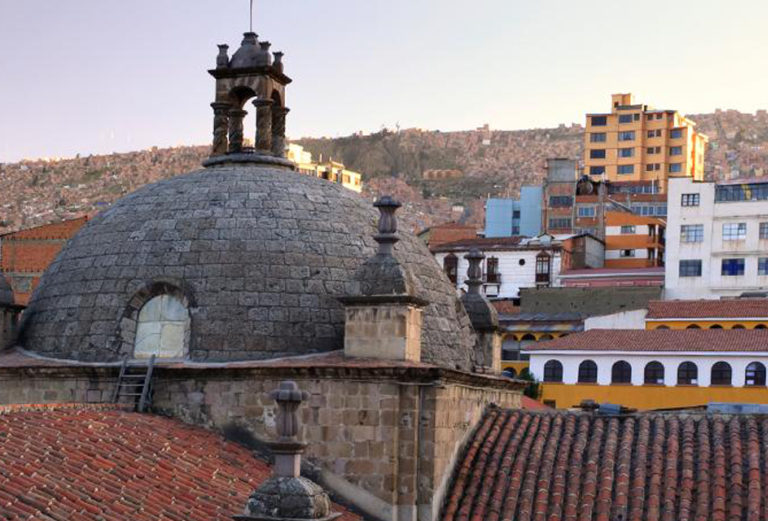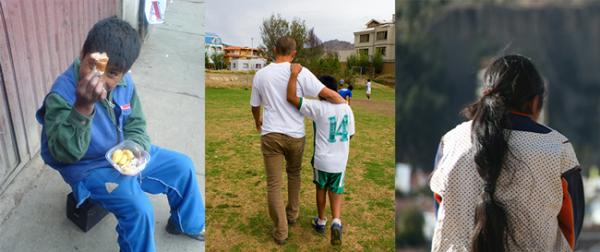The Streets Where We Live
A physician turns health care into hope for those living on the margins
- Profile

The bell tower of the Iglesia de San Francisco in La Paz faces an array of contemporary housing, old and new coexisting in a vibrant city that beckons those seeking change.
Today the word refugee evokes images of exodus, of the movement of people who have been driven from their homes by war, famine, or other cataclysms. To Chi-Cheng Huang ’97, however, refugee has a more immediate meaning: someone seeking protection from harm. For Huang, that someone is most often a child living on the streets of La Paz, Bolivia.
In 1997, while a student at HMS, and well before becoming chair of hospital medicine at the Lahey Clinic in Burlington, Massachusetts, Huang heard a Bolivian missionary tell members of the congregation at Boston’s Park Street Church about the lives of children living on the streets of La Paz. Congregants responded with generous contributions to support the missionary’s work, but for Huang, a monetary contribution was not enough. He had confronted significant obstacles during his own childhood and, as a result, had developed a deeply ingrained empathy for children at risk. Huang responded to the call for help by setting his medical studies aside for a year and boarding a plane to Bolivia.
The Thick of Things
Stories about individuals responding to humanitarian crises are not unusual at HMS. Alumni and faculty are often among the first to respond to disaster or need. In 2010, doctors, nurses, and other
medical personnel from the School and its affiliated hospitals streamed to Haiti within days of a powerful earthquake that devastated the island nation. David Walton ’03, an HMS instructor in medicine at Brigham and Women’s Hospital and deputy chief of mission to Haiti for Partners In Health, well remembers the scene that met him and his colleagues when they arrived on the battered island. Working in badly damaged hospitals, living in cramped quarters, and buffeted by more than 50 major aftershocks that assaulted the island, Walton recalls long days spent mending wounds, surgically repairing crush-related injuries, and supporting the spirit of a traumatized people.
The importance of treating the spirit as well as the substance has been emphasized in the work of Ronald Kessler, the McNeil Family Professor of Health Care Policy at HMS, and by the Hurricane Katrina Community Advisory Group he directs. In longitudinal studies conducted in the New Orleans region three years after the hurricane, the group reported high levels of anxiety and depression among those interviewed. More troubling, they found that since the storm, the incidence of serious mental illness has increased within the affected population. In short, Kessler reported, the severity and occurrence of emotional trauma inflicted by such massive destruction can rise for several years after an event.
Kessler’s work on trauma associated with natural catastrophe adds to the ground-breaking work of Richard Mollica, an HMS professor of psychiatry at Massachusetts General Hospital, who investigated the long-term effects of stress on populations subjected to war, genocide, and other human-induced trauma. In 1981, Mollica, responding to the mental health needs of newly arrived refugees from Vietnam and Cambodia, founded the Indochinese Psychiatric Clinic. Thirty years later, that clinic has evolved into the Harvard Program in Refugee Trauma in Mass General’s Department of Psychiatry, where it continues to set the standard for treating the complex effects of extreme violence inflicted on whole populations.
Just as Mollica’s work became a template for programs at other universities and medical centers, its structure has influenced that of the more recently established Harvard Humanitarian Initiative. Co-led by Michael VanRooyen, an HMS professor of medicine at Brigham and Women’s, the initiative is applying analytic research methods to the field of humanitarian relief in an effort to bring evidence-based approaches to large, multi-institutional responses to natural and man-made calamities.
Yet before most large, heroic aid efforts begin, there is one person, perhaps two, who sees a need and works to meet it. So it was with Huang when he visited La Paz.

Bag Diplomacy
Huang had arranged to volunteer at two of the orphanages in La Paz. Although he was still in medical school, he quickly became “Dr. Chi,” treating wounds and illnesses with the meager supply of antibiotics and disinfectants available at the orphanages. Sometimes, he supplemented these supplies with those he purchased from local pharmacies with his monthly meal stipend. This was, after all, just going to be a short stint of public service, six months at the most.
Huang began to venture onto the city’s darkened streets, sometimes on his own and sometimes with a staff member from one of the orphanages. Huang knew the street children would not readily trust an adult and that he would need to be creative and genuine if he was to win their confidence. So he filled a backpack with what turned out to be an effective set of tools: medical supplies, song sheets, and a soccer ball. A pickup soccer game or an impromptu singalong always drew a crowd of children.
Sometimes kids he had treated at one of the orphanages would help Huang break the ice. They spread the word that Dr. Chi was okay, and, in short order, new patients came out of the shadows to have him assess their ailments.
In the course of treating their physical maladies, Huang learned of the trauma inflicted upon their psyches. Most of the children had fled to the city from abusive homes, eventually finding kindred souls on the streets. The children learned how to earn a living in one of the available professions: thief, prostitute, or salesman, selling anything from potato chips to holy cards. They also discovered the cheap and reliable escape offered by sniffing yarn soaked in paint thinner.
The children Huang worked with were refugees in their own land, living on the streets by night but nearly invisible by day. Adults, they had quickly learned, didn’t want to acknowledge their existence. But Huang got to know the street children by name. Some of them were children he began to think of as his own.
Huang realized he could not leave. Six months turned into 15 years, during which he split his time between La Paz and Boston while finishing medical school and residencies at Brigham and Women’s, Mass General, and Boston Children’s Hospital.
“I was burned out three or four times,” Huang says, “and financially bankrupt twice.” He realized he needed to get others involved, starting with the members of the Park Street Church. To no one’s surprise, Huang proved adept at recruiting and fundraising. A nonprofit organization for the children was born.
Active Voice
Vaughn Mankey ’01, who now has a private psychiatry practice in West Lake Hills, Texas, was one of Huang’s early recruits. “Chi didn’t try to romanticize his message,” Mankey recalls. “He made it clear this was no ‘semester abroad’ adventure.” As a member of one of the first teams to go to La Paz, Mankey helped set up the organization’s initial residence for ten street children by integrating behavioral modification principles into its programs. Some of the principles echoed those implemented in residential psychiatric programs for children while others were meant to provide positive parenting guidelines to the orphanage staff who worked with the children.
Those first residential programs were frustrating in the beginning. “So many kids went back to the streets,” Huang says. But frustration led to action: The organization began to investigate barriers that kept children from abandoning life on the streets.
Other subjects for research sprang up: What support would a child need before returning to school? When the children became parents, how would they cope with caring for infants and toddlers? Were there best practices available that indicated how to intervene to help at-risk families?
In 2008, supported by a decade of investigating these questions, the growing group of volunteers in La Paz and Boston tuned the scope of the organization’s programs. They also formalized the organization’s name to Kaya Children International. In the same year, the newly named group opened the Kaya Center in La Paz. The center’s activities complement Kaya’s street outreach and residential programs by offering in-house tutoring for children about to enter the school system; day programs that include employment training for older youth; individual, group, and family counseling; recreational activities; meals; and crisis support. Currently, 31 children who live in Kaya’s residential program, together with another 62 children and 10 mothers, are served by the Kaya Center.
According to the organization’s executive director, Sarah Porter, the group works to meet the immediate needs of those living on or near the streets, while also serving as part of a larger effort working toward a future where no child calls the streets home.
Huang says that although he now enjoys the less-demanding role of Dr. Chi, founder, he still cherishes the memories of the children he has met.
“Some of the kids came up with the name ‘Kaya Children,’ ” Huang says. The word kaya means tomorrow in Quechua, one of the indigenous languages of Bolivia. “That was an encouraging choice. When refugees start to hope for a better tomorrow, they cease to be refugees.”
Michael Rafferty is a health and medical writer based in Massachusetts.
Images in collage: Kaya Children International (left and center); John Eggan